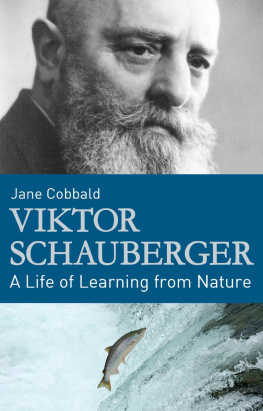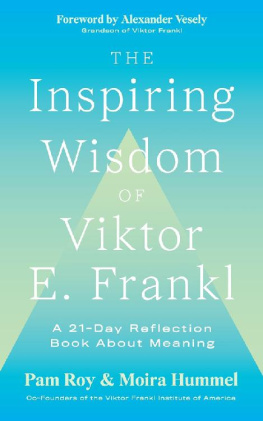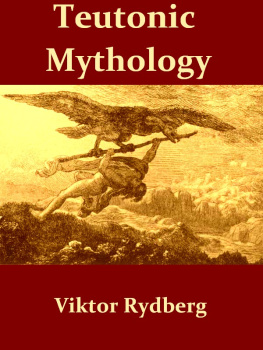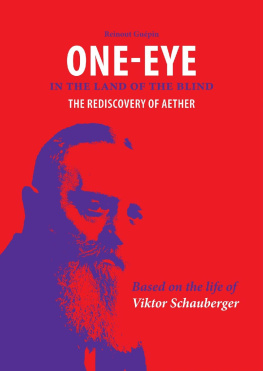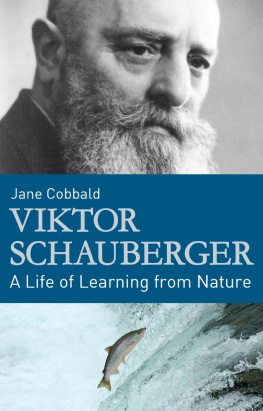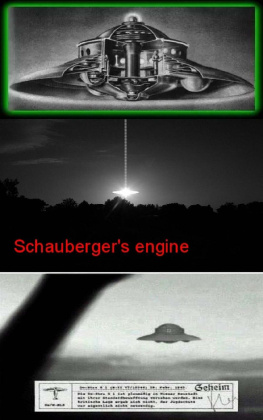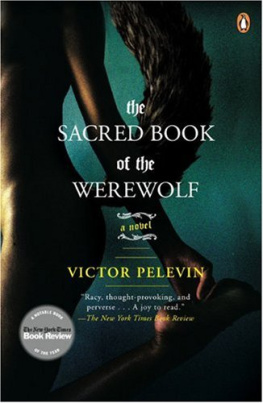Cobbald - Viktor Schauberger
Here you can read online Cobbald - Viktor Schauberger full text of the book (entire story) in english for free. Download pdf and epub, get meaning, cover and reviews about this ebook. year: 2016;1989, publisher: Floris Books, genre: Religion. Description of the work, (preface) as well as reviews are available. Best literature library LitArk.com created for fans of good reading and offers a wide selection of genres:
Romance novel
Science fiction
Adventure
Detective
Science
History
Home and family
Prose
Art
Politics
Computer
Non-fiction
Religion
Business
Children
Humor
Choose a favorite category and find really read worthwhile books. Enjoy immersion in the world of imagination, feel the emotions of the characters or learn something new for yourself, make an fascinating discovery.
Viktor Schauberger: summary, description and annotation
We offer to read an annotation, description, summary or preface (depends on what the author of the book "Viktor Schauberger" wrote himself). If you haven't found the necessary information about the book — write in the comments, we will try to find it.
Viktor Schauberger — read online for free the complete book (whole text) full work
Below is the text of the book, divided by pages. System saving the place of the last page read, allows you to conveniently read the book "Viktor Schauberger" online for free, without having to search again every time where you left off. Put a bookmark, and you can go to the page where you finished reading at any time.
Font size:
Interval:
Bookmark:
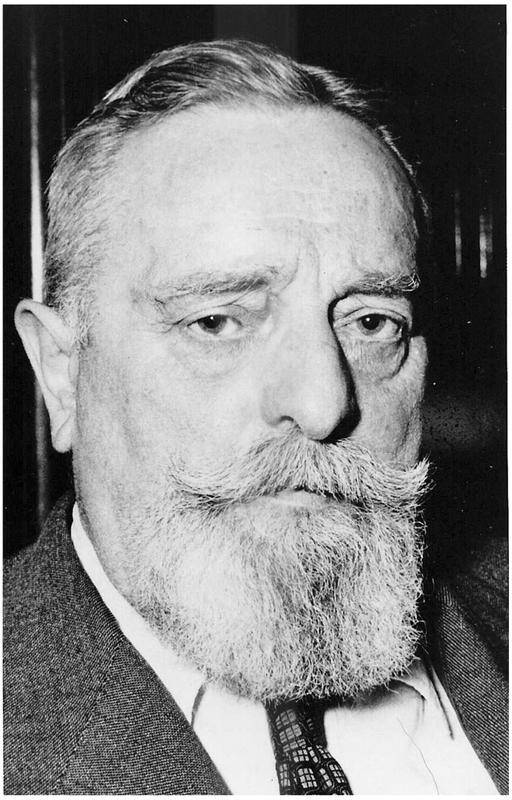
Viktor Schauberger (18851958)
This book is dedicated to Frau Ingeborg Schauberger, a remarkable and determined lady who kept faith with her father-in-law for over fifty years.
Some good friends have helped me with this book. They include, in Australia, Jenny Mitchell; in Austria, Wolfgang and Susanne Prock, Johannes Stadler, Jrg and Ingrid Schauberger and Frau Ingeborg Schauberger; in Sweden, Curt Hallberg; and in the UK, Alick Bartholomew, Nick Raeside, Denise Tearle and Gill Whitehurst. My gratitude to you all, and particular thanks to my partner Nigel Thorley, who has been remarkably good-natured throughout this project.
As this book covers some contentious areas, there are bound to be differences of opinion about its content. For those, and any errors in the text, I take responsibility.
Jane Cobbald
More thanks are owed: to Jrg Schauberger for taking the time to correct, clarify and expand some of the text of the first edition, and to all at Floris Books for taking a leap of faith with an unknown author. And especially to Callum Coats, for his extraordinary work in translating the Schauberger archive, an enterprise of nearly two decades. This book is based on those translations.
Viktor Schauberger lived in the first half of the twentieth century, in a world with different values from today. One of the changes that has taken place since then is in the attitude to hunting. For his generation, it was part of the natural order of things that humans should hunt. He saw no contradiction between this and his huge respect for Nature. Nowadays, as the world is more complicated and many wildlife species are endangered, some of us are ambivalent about it. However, it is undeniable that many of his most extraordinary stories are from the times when he was out alone in the mountain forests, hunting.
A note on the illustrations:
This book contains a selection of drawings by Viktor Schauberger that have not been published before in book form. They are part of a series of sketches that he drew in the years 1946 and 1947. This was a difficult period for him, and his country. He was unable to continue with any of the projects that he had previously been working on. He was isolated and housebound. Prevented from working on any outward, practical ventures, he turned inward. The drawings were made on lined paper and most of them had no accompanying text.
For me, they allow a glimpse of the world as Viktor Schauberger saw it. They show his observation of the patterns in Nature, and his recognition of their significance. Some of them look like eddies in a stream; others like cogs in a machine. Still others could be interpreted either way. They are all part of a continuum, showing his fascination with the unending processes he saw at play around him. They demonstrate his motto: kapieren und kopieren, comprehend and copy; in other words, first understand Nature and then copy it.
Abbreviations of Schauberger sources used in the text:
WW refers to The Water Wizard
NAT refers to Nature as Teacher
TFE refers to The Fertile Earth
EE refers to The Energy Evolution
Full details of these books can be found in the References and Further Reading section
by Alick Bartholomew
Viktor Schauberger made an extraordinary contribution to knowledge of the natural world. He is celebrated for his discoveries in the water sciences, in agricultural techniques, and in the energy domain what enhances and what harms life. Schauberger provides us with a comprehensive and holistic approach to understanding Nature. Using Natures cool methods, he invented energy generation devices to release people from enslavement to destructive sources of energy. He developed agricultural methods to enhance the quality of soil and crops.
Schauberger showed that when the natural ecosystems are in balance and biodiversity rules, there is great creativity and evolution of higher and more complex life forms, but there is also order and stability. When humans walked lightly on the Earth, we cooperated with Nature. While still part of her, we now behave as though we are superior, dominating other species and abusing the Earths bounty. Viktor warned, eighty years ago, that if we continued to go against Nature, the Earths eco-systems would become sick, the climate destructive and human society would break down, with extreme violence, greed and pandemic illnesses.
This is a very special book. From Janes fascination with her subject comes a curiosity to discover how Schaubergers mind worked. For Viktor was an intuitive and a visionary an engineer more than a natural scientist, whose preoccupation was to understand Natures intriguing processes. Jane Cobbald has given us valuable insights into Viktors worldview. She has skilfully worked his voice into the text, quoting anecdotes that give a flavour of his personality.
Most researchers learn from books what they to expect to see, and then observe what they unconsciously anticipated. Viktor Schauberger did not have these expectations. He observed with fascination as does a child. Jane, with a womans intuition, communicates this sense of wonder.
Her explanations of the importance of the right kind of motion, the most beneficial type of temperature change and the importance of egg shapes are very helpful. Her description of Viktors insights into how plants grow, the subtle energies involved and the electromagnetic interactions in water and the soil help to demystify these processes.
After Viktors death, his son Walter set up the Schauberger research institute, the Pythagoras Kepler School. Janes conversation with his widow, Frau Ingeborg Schauberger, helps to bring alive the relationship between father and son.
Landscape healer and inventor of environment-friendly technology, Viktor Schauberger vividly described how our disdain for Natures ways will bring only environmental catastrophe. His vision of humanity working within Natures laws is the path we must rediscover, if we are to survive.
He had little ambition for himself, but with the understanding he acquired of how to live in harmony with our environment, he devoted his life to improving the lives of others. His insights are vital for us today when the prevailing scientific paradigm sees the Earth as inert matter and Nature is observed as a mechanical system, its resources exploited for humanitys benefit, contributing to the appalling desecration of the environment, and to climate change. Here, Jane Cobbald has produced a work that advances, at a very readable level, the understanding of the vastly important and relevant principles that Schauberger discovered.
I grew up on a farm, and I remember registering an undercurrent of distress, a wondering whether humans relationship to the earth and its creatures really has to be like this. I remember the sheep in the lambing sheds in spring. Sheep are still semi-wild, and although physically well cared for, the sheds did not seem to be the right place for them. The cultivated fields did not attract me either. The woods and wilder, less interfered-with parts of the farm were where I wanted to be.
I read about Viktor Schauberger as an adult, in the 1990s, and was inspired by the reports of his work with copper implements. It seemed such a simple yet elegant idea. Perhaps, after all, it was possible to find a different way of working with the earth.
I had to wait another ten years before I could pursue the idea any further. By then I had a garden, a typical English garden with flowers and vegetables. I was not a very successful gardener, although an enthusiastic one. Then I started using copper tools in my garden. As I worked with them, it gradually dawned on me that this felt very different. The tools slice into the soil with a clean cut. It feels as if one is working with the soil, not against it. In contrast, using my old iron tools made me feel that I had been imposing my will on the garden.
Font size:
Interval:
Bookmark:
Similar books «Viktor Schauberger»
Look at similar books to Viktor Schauberger. We have selected literature similar in name and meaning in the hope of providing readers with more options to find new, interesting, not yet read works.
Discussion, reviews of the book Viktor Schauberger and just readers' own opinions. Leave your comments, write what you think about the work, its meaning or the main characters. Specify what exactly you liked and what you didn't like, and why you think so.

